|
For a few words about my
reviewing process and preferences, please see the introduction to
Classical Review # 36.

|
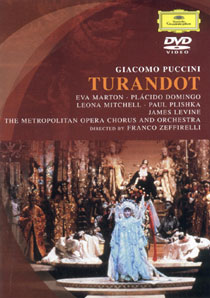 |
|
TURANDOT * MARTON, DOMINGO, MITCHELL,
PLISHKA, CUENOD
THE METROPOLITAN OPERA CHORUS AND
CHORUS, LEVINE COND.
ZEFFIRELLI DIRECTOR
MET NYC 1987
DG DVD VIDEO B0000852-09
|
|
0 |
5 |
|
Performance |
 |
|
Sonics |
 |
|
|
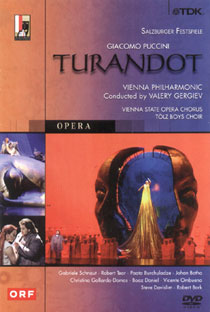 |
|
TURANDOT
SCHNAUT, BOTHA, GALLARDO-DOMAS,
BURCHULADZE, TEAR * VIENNA STATE OPERA CHORUS, TÖLZ BOYS CHORUS,
VIENNA PHILHARMONIC, GERGIEV COND.
POUNTNEY DIRECTOR * SALZBURG 2002
TDK DVD VIDEO
|
|
0 |
5 |
|
Performance |
 |
|
Sonics |
 |
|
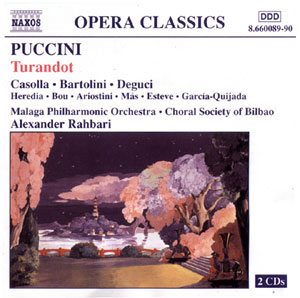 |
|
TURANDOT
CASOLLA, BAROLINI, DEGUCI, BOU, HEREDIA
MALAGA PHILHARMONIC ORCHESTRA, CHORAL
SOCIETY OF BILBAO, RAHBARI COND.
NAXOS 8.660089-90
|
|
0 |
5 |
|
Performance |
 |
|
Sonics |
 |
|
Ever since Arturo Toscanini conducted the 1926 debut of
Giacomo Puccini's unfinished final opera, Turandot, the work has become
synonymous with everything grand about Grand Opera. A successful production
demands mammoth forces: elaborate sets, huge voices of Wagnerian proportions
capable of cutting through the elaborate orchestration, and a large orchestra
and chorus led by a conductor capable of propelling the drama. Indeed, major
opera companies seem determined to outdo each other in the scope of their
productions, enlisting the finest directors and designers to bring the
quasi-Oriental spectacle to life.
The success of a production hinges in large part on the artistry of the two
principles, the Ice Princess Turandot and her suitor, Prince Calaf. While both
roles demand a forte high C, Turandot must initially appear imperious,
vengeful, and out for blood, later transforming into a human with a heart,
while Calaf must express headstrong confidence, ardor, and consummate passion
throughout. Turandot's final transformation from frigid princess to conquered
virgin is especially difficult to pull off; most sopranos who can muster the
cutting force to convincingly belt out her chilling “In questa reggia” have a
hard time sounding meltingly sweet in the final act.
A number of essential audio recordings of the work have been transferred to
CD. These include two assays by the great Birgit Nilsson, one from 1959 in RCA
Living Stereo with the unbeatable team of Björling, Tebaldi, and Tozzi, the
other from the 60s on EMI with Corelli, Scotto, and Mercuriali. The RCA set
conducted by Leinsdorf boasts the best sound plus a grandeur that has
converted many a music lover to opera queen, but EMI's Molinari-Pradelli takes
far greater advantage of the score's opportunities. A must-hear recently
released live 1965 performance on Living Stage stars Nilsson and Caballé (with
other less noteworthy principals) conducted by Previtali. Also essential is
the famed Sutherland, Pavarotti, Caballé, Ghiaurov recording on Decca
conducted by Mehta, and any lp or CD transfer you can lay your hands on of
Dame Eva Turner's 1928 commercial recording and/or 1937 Covent Garden
performance of Turandot with Martinelli and Albanese conducted by Barbirolli,
plus rare recordings of Liu's arias made in 1927 by the originator of the
role, Maria Zamboni.
Because it is such a spectacle, Turandot benefits greatly from the DVD
treatment. Although DVD sound can never approach the sonic supremacy of the
RCA and Decca studio recordings, surround sound, stunning visuals and
subtitles go a long way to compensate.
The absolute winner is the Met production. Eva Marton's prime (like Callas')
was shorter than one would have hoped, but she is captured here with her
resources mostly intact. Besides a few squally notes and an occasional moment
when the vibrato spreads, hers is a magnificently sung Turandot. The voice is
unyielding in its cutting power, yet convincingly tender at the opera's
conclusion. Her acting, too, is quite good, with stylized, pseudo-Oriental
gestures and icy stares betraying no other emotion until the final scene.
There, small changes in facial expression show her variously defiant, fearful,
cunning, and captured.
Domingo is a marvel. Save for two small imperfections, a crack on his high C
with Marton and a rather steely high B in “Nessun dorma,” his singing is all
one could wish for. Not only is the basic tone glorious and filled with ardor,
but he employs a wealth of shading, including a honeyed piano ritard in the
middle of “Nessun dorma” during which the camera spies him smiling in
satisfaction. The man's voice has lasted so long because he so loves the act
of singing. It's a wonderful performance, complemented by sufficiently strong
stances and arm gestures to prove convincing.
With much too little of Leona Mitchell available on disc, her achievement as
Liu deserves special praise. The voice is as beautiful and sincere as her
facial expressions, the pathos of her character heightened by consummate vocal
shading. Mitchell's interpretation seems reminiscent of Golden Age singing in
that she strings out notes and phrases for effect, producing heart-tugging,
melting pianissimi on her high notes. Although she ultimately cannot achieve
100% of her vocal intentions, the intent itself is so strong that the
performance is a triumph. Mitchell's love confession in the final scene, the
suddenness of her suicide, and her devotion to Paul Plishka's well sung Timur
are all equally memorable.
Listening to the routine conducting and playing on the Naxos disc, which while
acceptable at bargain price cannot challenge the primacy of other CD versions,
underscores the greatness of Levine's achievement with the Met Orchestra.
While it is questionable whether Rahbari's principals, given their vocal
limitations, could ever muster the shading and nuance of Levine's, their
conductor rarely gives them the chance.
Levine, on the other hand, is always supportive of his singers. No artist
attempting what Mitchell accomplishes sings the same way each time, but Levine
is always right with her, drawing out phrases with a complementary level of
concentration and focus. Grand passages have ideal weight, climaxes are truly
climactic, colors are extraordinary. Note, for example, that when the audience
interrupts the orchestral conclusion of “Nessun dorma” with pronounced
applause, Levine, rather than hurrying the accompaniment along in workaday
fashion, makes it even more dramatic, sounding each chord as if it were an
essential part of the score.
Finally there is the production itself. Zeffirelli has been creating opulent
settings since the days of Callas, and his mastery is apparent in every scene.
The sets are gorgeous, Gil Wechsler's lighting ideal, the costumes by Dada
Saligeri and Anna Anni superb. The Met TV forces do a great job of capturing
Zeffirelli's intoxicating opulence, using angled photography to heighten the
contrasts between verticals and diagonals. This DVD is arresting from start to
finish. Although there's excessive compression, reverberation, and brightness
on the voices, and the women in the chorus frequently sound tremulous and over
the hill, in the end one is swept away by the sum of it all.
The Salzburg production is a different animal entirely. Rather than a visually
mesmerizing period setting, David Pountney and costume designer Marie-Jeanne
Lecca attempt to illustrate the fear of technological control and annihilation
endemic to the 20s and 30s by creating a Star Trek-influenced,
compartmentalized industrial state in which Ping Pang and Pong mechanically go
about their business in Borg-like fashion. It is far more square than
Zeffirelli's conception, which is precisely the point.
In the Second Act, Turandot appears elevated to enormous height, shrouded in a
robe perhaps 30 feet long. When Calaf solves her riddles, however, she lowers
to stage level, sheds her robe, and becomes human in height. The Third Act
setting is much simpler, for reasons that will become apparent shortly.
I would have been far more involved if the sound had been less dry and
Gabrielle Schnaut hadn't squealed, wobbled, shrieked, and approximately
pitched her way through “In questa reggia.” Johan Botha has a sweet voice,
albeit with highs a bit pinched, but he is neither a virile Calaf, pleasing to
look at, nor convincing as an actor. Neither singer has a low range worth
writing home about. Christina Gallardo-Domas, however, presents a most moving
and sympathetic Liu. She is not in her best voice in the First Act's “Signore,
ascolta,” but rises to the fore in the Third Act “Tu che di gel sei cinta.”
Gallardo-Domas works hard to achieve her pianissimi, none of which are as
meltingly lovely as Mitchell's, but there is a simple pathos to her
performance that earns deserved bravos from the audience at the final curtain
call. Gergiev's conducting seems more self-effacing than Levine, but what he
does with the Vienna Philharmonic's gorgeous string section in the final act
is a sign of greatness.
When Puccini died in 1924 at the age of 66, he had only completed sketches of
the opera's final two scenes. With the concluding duet that depicts Turandot's
essential transformation unfinished, composer Franco Alfano was enlisted to
complete the opera. When his initial efforts did not meet with the approval of
conductor Arturo Toscanini, Alfano created a second version, shortened by a
third. Though Toscanini honored Puccini at the premiere by ending the opera
unfinished, he led the first performance of Alfano's shortened completion two
days later, on April 27, 1926. (The longer Alfano ending was not heard until a
London concert performance in 1982). Alfano's orchestration may not sound much
like Puccini's, but his recapitulation of major themes and reinforcement of
Puccini's grandeur have proven such a success that his completion has become
standard performance practice.
This Salzburg DVD offers the first recording of the late Luciano Berio's
alternate completion of the opera's final two scenes. With its new orchestral
interlude and far more restrained ending, Berio's conclusion replaces
quasi-celestial grandeur with a far more reflective and sobering view of the
redemptive power of love. Many will miss the oversized spectacle of Puccini/Alfano/Zeffirelli,
but there is a depth to the Berio/Pountney conception that demands to be seen
and heard.
After Liu sacrifices herself on Calaf's behalf, her lifeless corpse is placed
on a surgical table with Turandot and Calaf positioned on either side. As
Berio's extended new orchestral interlude signals Turandot's transformation
from imperious Princess to compassionate being, she begins to wipe Liu's body.
The washcloth is then passed to Calaf, who continues to bathe the body until
the two protagonists perform the final cleansing together.
To music simultaneously mysterious and subdued, the chorus gradually comes
forward, dressed in modern clothes. Standing on the same bare stage as her
“subjects”, Turandot embraces Calaf as members of the chorus (who sing far
better than the Met's forces) break into couples and embrace as well. Though
we at times hear Puccini's familiar melodies, the far less ecstatic
orchestration, a century apart from Puccini's language, concludes the opera on
a far more human note.

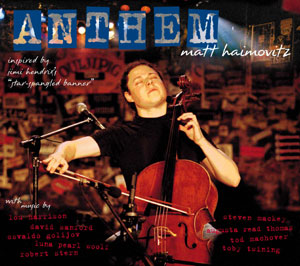 |
|
MATT HAIMOVITZ: ANTHEM
OXINGALE OX2004
|
|
0 |
5 |
|
Performance |
 |
|
Sonics |
 |
|
If Jimi Hendrix had reincarnated as a cellist, he would
surely have delivered his myth-shattering version of the “Star Spangled
Banner” with a ferocity equal to this. The opening cut on his solo disc of
contemporary American music for cello, Haimovitz's explosive interpretation of
Hendrix' classic “Anthem” sets the tone for a CD whose vision of America's
post 9-11 future serves as a sonic wake-up call to the apocalyptic connivings
of Bush and Company.
Anthem was recorded live on October 11, 2002 at CBGB, a New York punk rock
club whose walls shook anew from the screams of Haimovitz's cello. It joins
ten other tracks on a disc driven by “an incredible fear of where our
political leadership is taking us at this time” as well as a “love of this
country and sense of patriotism.” Two of the selections, David Sanford's
“Seventh Avenue Kaddish” and Toby Twining's “9:11 Blues” were commissioned
especially for Haimovitz's current Anthem tour of all 50 states (http://www.oxingale.com).
They join five other first recordings: Osvaldo Golijov's “Omaramor,” Luna
Pearl Woolf's “Impromptu,” Robert Stern's “Recitative (Yom Teruah),” Tod
Machover's “With Dadaji in Paradise,” and Matt Haimovitz's “Truth from Above”
improvisation on a Vespers melody.
After “Anthem,” alone worth the price of admission, the disc continues with
the late great composer Lou Harrison's Prelude to Rhymes with Silver. Although
the piece was composed for Yo-Yo Ma and the Mark Morris Dance Company,
Haimovitz performed in the New York premiere with Morris. Lou had intended to
arrange the work's solo cello movements into a stand-alone suite, but died
before he could begin. This is a definitive rendition.
“Seventh Avenue Kaddish,” composed by the winner of the 2002 Rome Prize,
places the cellist near ground zero, wailing on the streets of New York as
buildings collapse, debris blinds, and asbestos-laden dust suffocates. What
the EPA did not say about the air, Sanford clarifies through music of slashing
intensity. Robert Stern's “Recitative (Yom Teruah) is gripping in its
desperation. Steven Mackey's “Rhondo Variations” include knocking on the cello
body and screeches. Augusta Reed Thomas' hauntingly beautiful “Bells Ring
Summer” in her own words “celebrates the vast color fields of the cello
itself.” Machover's “With Dadaji in Paradise” reflects his experience playing
Bach solo suites throughout India, while Twining's great “9-11 Blues” is true
to its name. For an introduction to the modern American musical imagination
and a raw look at what we're facing, Anthem demands to be heard.

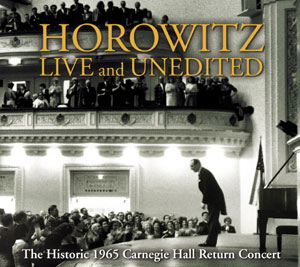 |
|
HOROWITZ LIVE AND UNEDITED – THE
HISTORIC 1965 CARNEGIE HALL RETURN CONCERT
SONY S2K 93023
|
|
0 |
5 |
|
Performance |
 |
|
Sonics |
 |
|
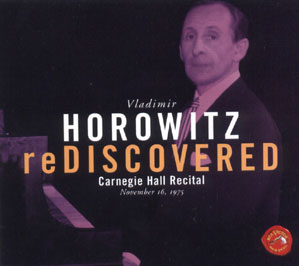 |
|
HOROWITZ REDISCOVERED
RCA VICTOR 82876-50749-2
|
|
0 |
5 |
|
Performance |
 |
|
Sonics |
 |
|
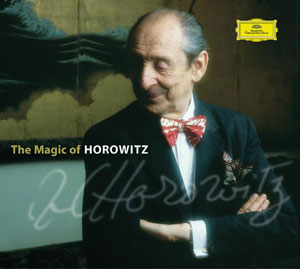 |
|
THE MAGIC OF HOROWITZ
DG 474 334-2
|
|
0 |
5 |
|
Performance |
 |
|
Sonics |
 |
|
October 1 marked the centennial of the birth of pianist
Vladimir Horowitz. Born in Kiev, Vladimir Gorowitz (as he was known before he
anglicized his surname) was all of nine when, as a recently enrolled student
in the Kiev Conservatory, he snuck into a sold-out recital by the great
pianist Josef Hoffmann and hid in a dark corner spellbound. Almost 74 years
later, after an absence of 61 years, Horowitz returned to Russia to play for
an equally spellbound audience. It was a triumphant homecoming, the
culmination of a career that ended three years later with his sudden death.
Though frequently dubbed the last great exponent of the Russian tradition of
romantic pianism, Horowitz himself resisted the term. In comments printed in
the brochure to The Magic of Horowitz, edited by one of his long-time
recording producers Thomas Frost, the pianist revealed his approach to music
making:
“Classical, Romantic, Modern, Neo-Romantic! These labels may be convenient for
musicologists, but they have nothing to do with composing or performing . . .
. All music is the expression of feelings, and feelings do not change over the
centuries. Style and form change, but not the basic human emotions . . . .
“All my life, ever since I was a young man, I have considered music of all
periods romantic. There is, of course, an objective, intellectual component to
music insofar as its formal structure is concerned; but when it comes to
performance, what is required is not interpretation but a process of
subjective re-creation.
“The notation of a composer is a mere skeleton that the performer must endow
with flesh and blood, so that the music comes to life and speaks to an
audience… An audience does not respond to intellectual concepts, only to the
communication of feelings.”
To celebrate Horowitz's centennial, RCA has recently released the two-disc
Horowitz Rediscovered, the first time that the pianist's entire live Carnegie
Hall Recital of November 16, 1975 has been issued in complete and unedited
form. New to Horowitz's discography are two Rachmaninoff Êtudes-Tableaux and
the Schumann Blumenstück. The sound is not as rich as one would like, but much
of the playing is extraordinary.
On September 30 Sony Classical issues Horowitz Live and Unedited – The
Historic 1965 Carnegie Hall Return Concert. This priceless document documents
Horowitz's May 9, 1965 return to the concert hall after 12 years of isolation,
with many years spent entirely at home with Wanda and his Steinway.
Accompanying the set is a bonus 10-minute DVD of previously unreleased
outtakes from the film The Last Romantic. Also due from Sony is a newly
compiled three-disc set, In the Hands of the Master – Vladimir Horowitz: The
Definitive Recordings, featuring stereo recordings made between 1962 and 1989
(the year of his death), plus 12 other reissues.
Even auditioned from a pre-release CD-R, Horowitz Live and Unedited qualifies
as one of the finest sounding recordings of Horowitz's artistry. Not only does
Sony's recently developed Direct Stream Digital (DSD) processing deliver
superior digital sound, but the decision to bypass studio edits has also
enabled engineers to work from the original three-track analogue tapes. As a
result, we hear far more of the wealth of color that made the man's playing so
extraordinary.
DG has just released The Magic of Horowitz. This two-disc set of recordings
from the master's final years includes a tempting new bonus DVD-Video,
Horowitz plays Mozart which documents the making of Horowitz's final concerto
recording; music from the triumphant 1986 Leningrad return concert; plus three
previously unreleased performances, two of works new to Horowitz's
discography. Though the somewhat brittle early digital recordings have not
been remastered, these new pressings offer fuller sound than the original
issues. Most important, performances of such gems as Rachmaninov's Preludes in
G major and G sharp minor are truly magical, seeming to emanate from a plane
on which music speaks as the supreme voice of the human heart.
Horowitz always performed on his personal Steinway. With hammers finished with
special lacquer, and action specifically adjusted to enable fine gradations of
shading, the instrument served as an extension of the man's genius, enabling
him to take the risks necessary to reveal the extraordinary range of emotions
he felt through music. This makes comparison of various live versions of the
same piece most enlightening.
Each label's release includes a live version of Schumann's “Träumerei.” Though
one cannot assume that Horowitz played faster as he aged, his live renditions
of this signature encore grew shorter with each concert. To these ears, the
Carnegie 1965 version (37 seconds slower than Leningrad's from 1986) is the
most eloquent, with Horowitz seeming to ruminate over every note, frequently
whispering sounds as if suspended in a dream state. To contrast this with the
enlivened sparkle of Moszkowski's étincelles (1975) or the soul-shaking
intensity of Chopin's Scherzo No. 1 in B Minor (1975) offers a stunning
introduction to the man's greatness.

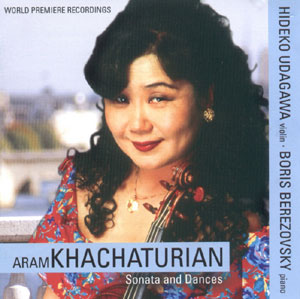 |
|
KHATCHATURIAN SONATA AND DANCES
HIDEKO UDAGAWA AND BORIS BEREZOVSKY
KOCH 3-7571-2-HI
|
|
0 |
5 |
|
Performance |
 |
|
Sonics |
 |
|
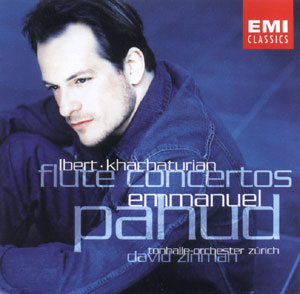 |
|
IBERT & KHATCHATURIAN'S FLUTE CONCERTOS
EMMANUEL PAHUD; TONHALLE-ORCHESTER
ZÜRICH, DAVID ZINMAN
EMI 724355-756329
|
|
0 |
5 |
|
Performance |
 |
|
Sonics |
 |
|
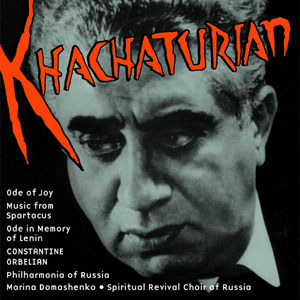 |
|
KHATCHATURIAN: SPARTACUS, ODE IN MEMORY
OF LENIN, ODE TO JOY
PHILHARMONIA OF RUSSIA, CONSTANTINE
ORBELIAN; MARIA DOMASHENKO; SPIRITUAL REVIVAL CHOIR OF RUSSIA
DE 3328 (SACD SURROUND VERSION COMING
LATER)
(Lamentably delayed and unavailable at press time but included for its
importance)
|
For most of his life, the music of Armenian composer Aram
Khatchaturian (1903-1978) was greeted with acclaim. If his oeuvre has since
fallen from favor, new CD releases and a slew of Centennial performances offer
opportunities to reassess his output.
Much of Khatchaturian's success lay in way he drew upon Armenian folk melodies
and rhythms to create energetic, frequently celebratory compositions that
struck a deep chord in the hearts of Eastern European listeners. Ukrainian,
Georgian, Zerbaijani, and Turkmenistani harmonies were also incorporated into
his writing, making him a Soviet favorite. His oft-played Sabre Dance derives
from his score to Gayaneh (1942), a four-act ballet about crisis and
reconstruction on a collective Soviet farm. (In Stanley Kubrick's 2001, an
adagio from this score mournfully accompanies the crew of Discovery as they
head off to Jupiter).
A late bloomer, Khatchaturian first graduated from the Moscow Conservatory at
age 30. By then, his early trio had attracted the attention of Prokofiev, who
arranged a performance of the work in Paris. In 1934, his First Symphony
received the first of many performances. His reputation was further enhanced
by his Piano Concerto (1937), which was promoted as the Soviet Union's first
“national” concerto, and the Violin Concerto (1940) written for and championed
by the great David Oistrakh.
Yet, in 1948, despite serving as an executive of the Union of Soviet Composers
and penning both the Armenian National Anthem and such party-glorifying works
as the Song of Stalin and Funeral Ode in Memory of Vladimir Ilych Lenin,
Khatchaturian found himself condemned. Lumped together with Shostakovich,
Prokofiev and Miaskovsky, he was officially denounced by the Central Committee
of the Community Party for “formalist” compositional tendencies.
Khatchaturian did not follow Shostakovich's path by composing gut-wrenching,
frequently ironic cries of protest and pain; instead, crushed by the party's
condemnation, he issued an official apology. As acts of penance, he wrote
Stalin-pleasing scores for the films Lenin and The Battle of Stalingrad. He
even agreed to be sent back to Armenia to be reeducated.
After Stalin's death in 1953, Khatchaturian denounced the Committee's judgment
and was named People's Artist of the Soviet Union. Shortly thereafter, he
completed his best-known work, the score to the ballet Spartacus, later
revised and arranged into several orchestral suites.
Several new recordings celebrate the Khatchaturian Centennial. A lovely Koch
recital features violinist Hideko Udagawa and pianist Boris Berezovsky in
mostly world-premiere recordings. Their rendition of the early Dance No. 1
(1925) was made possible after the Khatchaturian family supplied the violinist
with the original handwritten manuscript. The longest work on the program, the
beautiful Sonata for Violin and Piano (1932), winningly melds Armenian
sensibility with French impressionism. Seven violin/piano arrangements of
orchestral soundfests strip away surface splash to reveal their harmonic
underpinnings. Most fetching are the energetic Dance of Egyna and heartfelt
Grande Adagio from Spartacus (reminiscent of the popular song “Til There Was
You”), and the catchy Nuneh Variation and Sabre Dance from Gayaneh. Two of the
arrangements are by Jascha Heifetz, who frequently programmed Sabre Dance as
an encore.
Udagawa, a protégé of Nathan Milstein, plays with piquant, occasionally resiny
tone. One wishes for more bite and sweetness, but her tang underscores
Khatchaturian's folkiness. Berezovsky, Gold Medal winner of the 1990
International Tchaikovsky Competition, provides ideally sensitive support,
while Koch's sonics offer excellent full-bodied immediacy.
Flautist Emmanuel Pahud joins David Zinman and the Tonhalle-Orchester Zürich
on EMI for Khatchaturian's Flute Concerto. (Ibert's Flute Concerto and piece
for solo flute round out disc). The Concerto, Jean-Pierre Rampal's 1968
transcription of the Violin Concerto of 1940 complete with a new cadenza, came
about after Khatchaturian offered the work to Rampal. Pahud supplies requisite
virtuosity, but his exceedingly breathy tone on all but the highest notes
fails to satisfy. (Pahud sounded equally breathy in a recent San Francisco
recital). Questionable acoustic perspective and edgy strings also lessen
pleasure.
Constantine Orbelian, an Armenian champion of Khatchaturian's work who just
conducted Khatchaturian Centennial Concerts in New Haven and Carnegie Hall on
October 8 and 10, has released a Delos disc (DE 3328) that includes music from
Spartacus, the 1948 Ode in Memory of Lenin and 1956 Ode to Joy. Unavailable at
press time, the disc promises both authenticity and, especially in SACD
surround sound, Delos' customary superior sonics.
These discs confirm Khatchaturian's facility for creating catchy, sometimes
repetitive tunes that overflow with exuberance. Despite the beauty of his
melodies, to this non-Armenian Khatchaturian sometimes seems a noisy
post-adolescent, creating a lot of fuss without plumbing the depths. Others
will be too busy tapping their toes to care.
- Jason Serinus
-
Terms and Conditions of Use

|













